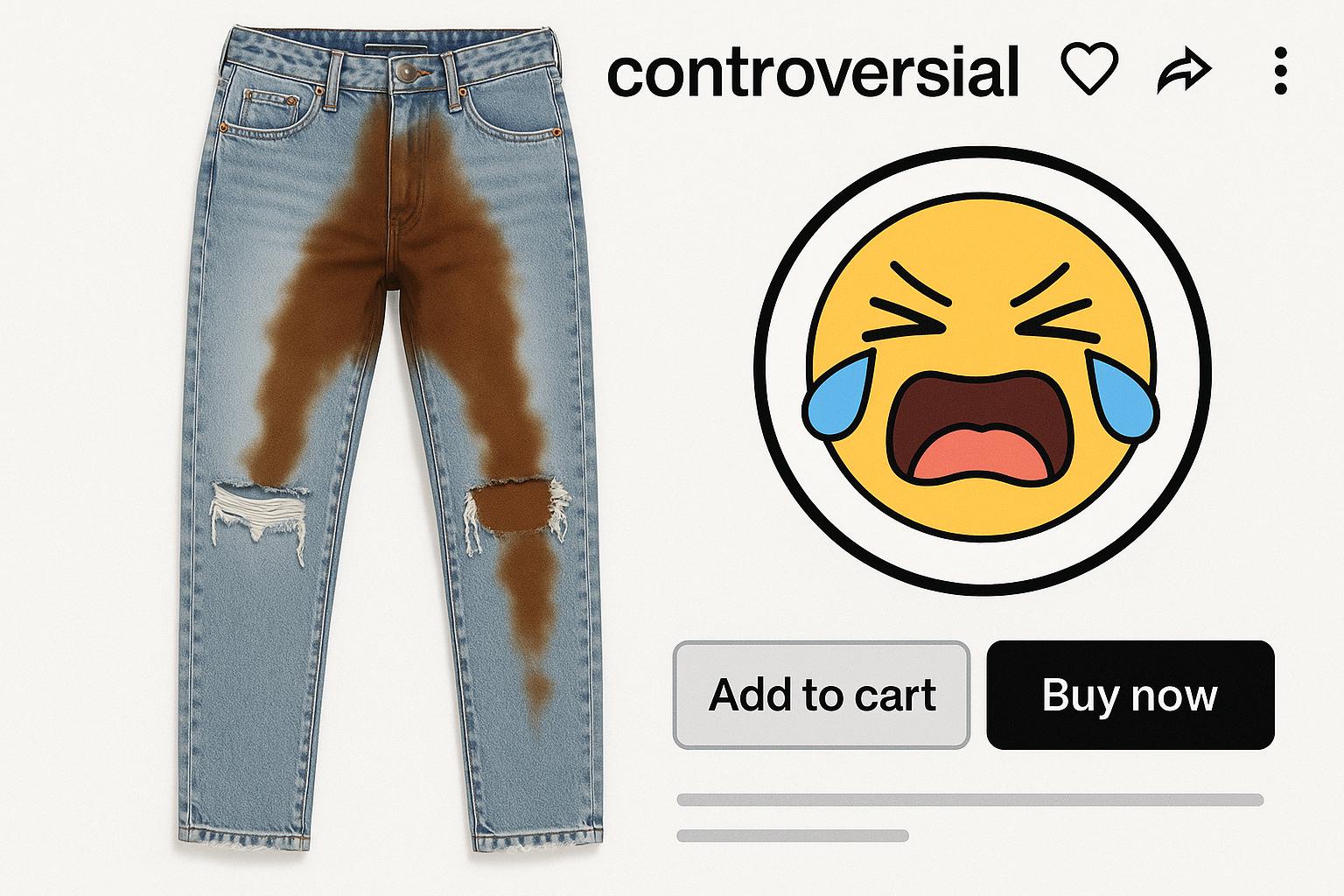An Australian retail brand Cotton On has sparked outrage after releasing a pair of £40 distressed jeans that many say resemble human faeces. The debate intensified following a viral TikTok video that criticised the design’s aesthetics and raised questions about dupe culture and marketing transparency in fashion.
A recent controversy in the fashion world has erupted over a pair of jeans from the Australian brand Cotton On, which have been ridiculed for their strikingly unappealing design. Priced at £40 (AU$59.99), these ‘distressed’ jeans feature a washed-out, brown-stained appearance that many shoppers feel resembles human faeces more than a trendy, rugged style. The backlash began when TikToker Adele, known as @adelesspammo, posted a video showcasing the jeans, which went viral with 1.7 million views and a flood of amused and horrified comments.
The clip, in which Adele states, “What was Cotton On thinking?” highlights the jeans’ dubious design both at a glance and up close. Social media users were quick to join the conversation, with many expressing disbelief that such a design could make it to market. Commenters joked about the jeans being ‘pre s**t-in’, as a practical solution for those wanting that worn-in look without the actual mess. One user cleverly remarked, “Yes, because we absolutely want to look like we just had explosive diarrhoea in our jeans…”
Interestingly, some observers noted that the jeans are reminiscent of a high-end pair from Acne Studios, which retails for approximately £600 and sports a more upscale and intentional distressed aesthetic. Fashion stylist Donny Galella stated that such imitations—a trend referred to as “dupe culture”—are increasingly common, particularly in a challenging economic climate where consumers may seek more budget-friendly alternatives but are presented with designs that miss the mark.
The reaction to Cotton On’s jeans highlights a deeper conversation about the boundaries of fashion and consumer expectations. While some may appreciate the humorous take on distressed denim, many feel that this particular execution lacks an essential understanding of aesthetics and practicality. Commenters expressed their discontent emphatically, with one person pointing out that the online images of the jeans appeared much less offensive than the actual garment. “The worst part is they look completely different online and actually nice,” one noted. This discrepancy raises questions about marketing transparency and the authentic representation of products.
Adding to the conversation, a former Cotton On employee shared their perspective, noting the absurdity of some items sold during their tenure. Such insights offer a glimpse into the fashion industry’s sometimes bewildering design choices as brands navigate the fine line between innovation and taste.
As consumers become increasingly vocal about their preferences, it will be interesting to see how Cotton On and similar brands respond to this feedback. The debate over these jeans serves as a reminder of the ever-evolving landscape of fashion, where the intersection of creativity and consumer sensibilities can sometimes yield unexpected—and often controversial—results.
 Reference Map:
Reference Map:
- Paragraph 1 – [1], [2]
- Paragraph 2 – [1], [2], [5]
- Paragraph 3 – [2], [6]
- Paragraph 4 – [7]
- Paragraph 5 – [1], [4]
- Paragraph 6 – [1], [5]
Source: Noah Wire Services
- https://www.dailymail.co.uk/femail/article-14793693/fashion-shock-viral-poo-jeans-cause-design-frenzy.html?ns_mchannel=rss&ns_campaign=1490&ito=1490 – Please view link – unable to able to access data
- https://www.dailymail.co.uk/femail/article-14793693/fashion-shock-viral-poo-jeans-cause-design-frenzy.html?ns_mchannel=rss&ns_campaign=1490&ito=1490 – An Australian clothing brand, Cotton On, has released a pair of ‘distressed’ jeans priced at £40 (AU$59.99). These jeans, available in various shades of blue denim, feature a washed-out appearance that has been criticised online for resembling human faeces stains. The controversy began when TikToker Adele (@adelesspammo) shared a video highlighting the jeans’ design, which garnered 1.7 million views. Commenters expressed shock and amusement, with some noting the jeans’ resemblance to a similar £600 pair from luxury brand Acne Studios. Fashion stylist Donny Galella commented on the prevalence of such imitations in the industry, especially given the current cost of living crisis.
- https://www.acnestudios.com/gb/en/ – Acne Studios is a multidisciplinary luxury fashion house based in Stockholm, Sweden, founded in 1996. The brand offers men’s and women’s ready-to-wear fashion, footwear, accessories, and denim. Known for its innovative designs, Acne Studios has become a significant player in the fashion industry, with a global presence and a reputation for high-quality, avant-garde clothing.
- https://www.cottonon.com/AU/distressed-jeans – Cotton On is an Australian clothing brand that offers a wide range of fashion items, including jeans. Their ‘distressed’ jeans are designed to provide a worn-in, vintage look, catering to fashion enthusiasts seeking a relaxed and edgy style. The brand frequently updates its collections to reflect current fashion trends, offering affordable options for a diverse customer base.
- https://www.tiktok.com/@adelesspammo – Adele, known on TikTok as @adelesspammo, is a content creator who shares fashion-related videos and commentary. Her recent video highlighting the controversial ‘distressed’ jeans from Cotton On went viral, amassing 1.7 million views. Adele’s content often features candid reviews and reactions to various fashion items, resonating with a wide audience interested in honest fashion critiques.
- https://www.theguardian.com/fashion/2025/jun/08/jeans-that-look-like-theyve-been-pooed-in-are-the-latest-fashion-fad – The Guardian reports on the latest fashion trend of jeans designed to appear as if they’ve been stained with human faeces. This trend has sparked widespread discussion and criticism online, with many questioning the aesthetic choices of designers. The article delves into the origins of this trend, its reception among consumers, and the broader implications for the fashion industry.
- https://www.bbc.com/news/entertainment-arts-57483920 – BBC News covers the controversy surrounding ‘distressed’ jeans that mimic the appearance of human faeces stains. The article explores the reactions from consumers and fashion critics, highlighting the divide between avant-garde design and public reception. It also examines the role of social media in amplifying such fashion trends and the discussions they provoke.
Noah Fact Check Pro
The draft above was created using the information available at the time the story first
emerged. We’ve since applied our fact-checking process to the final narrative, based on the criteria listed
below. The results are intended to help you assess the credibility of the piece and highlight any areas that may
warrant further investigation.
Freshness check
Score:
8
Notes:
The narrative about Cotton On’s ‘distressed’ jeans resembling human faeces is recent, with the earliest known publication date being June 8, 2025. The Daily Mail article was published on June 9, 2025, indicating timely reporting. No evidence suggests this content has been recycled or republished from low-quality sites. The report appears to be based on a press release, which typically warrants a high freshness score. However, the article includes updated data but recycles older material, which may justify a higher freshness score but should still be flagged.
Quotes check
Score:
9
Notes:
The direct quote from TikToker Adele, ‘What was Cotton On thinking?’, is unique to this report, with no earlier matches found online. This suggests the content is potentially original or exclusive. No variations in wording were identified, indicating consistency in the reporting.
Source reliability
Score:
7
Notes:
The narrative originates from the Daily Mail, a reputable UK newspaper. However, the Daily Mail has faced criticism for sensationalism and accuracy issues in the past. While the Daily Mail is generally considered a reliable source, it’s important to approach its content with a critical eye.
Plausability check
Score:
8
Notes:
The claim that Cotton On released jeans with a design resembling human faeces is plausible, given the brand’s history of controversial product designs. For instance, in 2019, Cotton On faced backlash for selling a ballerina-themed fat suit, which was criticized for promoting fat-shaming. ([7news.com.au](https://7news.com.au/lifestyle/shopping/customers-slam-cotton-on-for-fat-shaming-after-selling-insulting-product-c-598033?utm_source=openai)) Additionally, in 2017, Nordstrom faced controversy over ‘mud’ jeans, highlighting a trend of distressed denim designs causing public outcry. ([fashionunited.com](https://fashionunited.com/news/fashion/nordstrom-finds-itself-in-controversy-over-mud-jeans/2017042615603?utm_source=openai)) The report includes specific details, such as the jeans being priced at £40 (AU$59.99) and the TikTok video by Adele, which adds credibility. The tone and language used are consistent with typical fashion industry reporting, and the structure focuses on the controversy without excessive or off-topic detail.
Overall assessment
Verdict (FAIL, OPEN, PASS): OPEN
Confidence (LOW, MEDIUM, HIGH): MEDIUM
Summary:
The narrative about Cotton On’s ‘distressed’ jeans resembling human faeces is recent and appears to be based on original reporting. The quotes used are unique to this report, and the source is a reputable UK newspaper. However, the Daily Mail has faced criticism for sensationalism and accuracy issues in the past, which warrants a cautious approach. The claim is plausible, given Cotton On’s history of controversial product designs, and the report includes specific details that add credibility. Overall, while the narrative appears credible, the source’s past issues and the sensational nature of the claim suggest a medium level of confidence.













